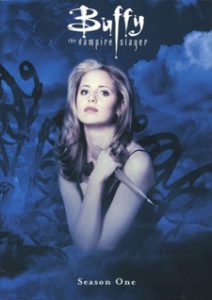“Buffy the Vampire Slayer” Season 1 (1997, The WB) stands apart from other shows’ first seasons in that it hits the ground running — Joss Whedon knows what he wants this show to be. On the other hand, it gets so much better in Season 2 and better still in Season 3 that Season 1 definitely has that innocence and charm that we nostalgically love about debut seasons of hit shows.
Great out of the gate
My first experience with these episodes predates my critical reading of them; my love of high school-era “Buffy” is deeply ingrained in my psyche. I got into “Buffy” in the summer after the second season, but I quickly caught up on VHS (the six officially released episodes, and the rest borrowed from a friend) with voracious viewings.
Now it’s gotten to the point where I don’t really need to watch Season 1 ever again, kind of like the original “Star Wars” trilogy.

“Buffy the Vampire Slayer” Season 1 (1997)
WB, 12 episodes
Creator: Joss Whedon
Starring: Sarah Michelle Gellar, Nicholas Brendon, Alyson Hannigan
Still, I tried to give it a more critical eye on this rewatching project. The fun part is that I got to rank the episodes by quality and analyze what made the series great out of the gates. Because, let’s face it, the 1992 “Buffy” movie starring Kristy Swanson (written by Whedon, but — significantly — not directed by him) proved that this same material could be presented poorly.
Here are the four key things that the two-hour pilot, “Welcome to the Hellmouth”/”The Harvest” does right that sets it apart from the “Buffy” movie:
- The vampires turn into dust when staked. The importance of this can’t be overstated. Honestly, if “Buffy” followed the previous (and since, in the case of “True Blood”) approach of having vamps die a blood-spurting, disgusting death and leaving a corpse, I probably wouldn’t be a fan of the show.
- Buffy makes friends, namely Willow, Xander and her Watcher Giles — but especially Willow. Watch the unaired “Buffy” presentation pilot on YouTube with another actress as Willow, and it’s clear that Alyson Hannigan saved the show.
- Whedon’s voice shines through. The “Buffy” movie treated Whedon’s quippy and pop-culture-laden dialogue as jokes to be highlighted in a “look at me” sitcom-style, but they play better in the natural flow of the conversation (Buffy tells Giles “I can’t believe you of all people are trying to Scully me,” and Giles — and the viewer — doesn’t miss a beat. Or Buffy says: “I think I speak for everyone here when I say ‘Huh?’ “). Although Whedon didn’t direct the two-hour pilot, he did direct the aforementioned test pilot and he clearly communicated how to speak “Buffy”-ese to his directors and actors. (See “Alien Resurrection” and the dialogue Whedon contributed to the first “X-Men” film for further examples of directors not understanding the flow of Whedon-speak.)
- The final-act fight scenes are mercifully short. This is because Season 1 didn’t have much of a fight-choreography budget and also, I suspect, because Whedon and his writers so enjoyed writing the Scooby Gang interacting with each other that it didn’t leave much time for dispatching the monster of the week. At any rate, it’s a good thing: “Buffy” often dodges clichés, but when it can’t avoid the cliché of the climactic fight scene, it gets it over with quickly.
Making up the mythology
It’s interesting to note that while Season 1 shows “Buffy’s” potential for having a rich, century-spanning and world-spanning mythology (something that the spinoff novel writers, not limited by budget, embraced), it’s also clear that Whedon is making things up as he goes along.

In “The Witch,” Giles says he is casting his first spell; the writers hadn’t thought up his Ripper backstory yet, or even the notion of thorough Watcher training.
Most notably, Angel — eventually the franchise’s second-most-major character — isn’t in the Season 1 opening credits. On the plus side, Whedon shows a knack for going with the flow — David Boreanaz clearly doesn’t know what he’s doing in the two-hour pilot, but in the episode “Angel,” his chemistry with Sarah Michelle Gellar explodes off the screen.
It was perhaps at that point that the writers found their Season 2 storyline and began to devise Angel’s rich backstory.
But the biggest thing missing from Season 1 is Christophe Beck’s orchestral score; he joined the show in Season 2. A “Buffy” score finally was released on CD in 2008, and it starts with Season 2 — not a single fan in the world complained. The Season 1 score isn’t offensively bad, but it’s certainly generic and dated — and OK, it is rather bad.
Even without that key tool, Season 1 produced “Buffy’s” first masterpiece episode, plus 11 more that I can’t help but love despite their flaws. Here are my rankings:
1. “Angel” (episode 7, written by David Greenwalt)
“Buffy” is one of the few shows (“My So-Called Life” and “Once and Again” are the others) that can make me stare numbly at the screen after the credits and absorb what I’ve felt emotionally. It’s a combination of “What a masterpiece of TV” and “What a cruel world we live in, where good people have to feel pain like that.”
The Buffy-Angel romance has stunted my emotional growth in that I still believe in soul mates — the idea that two people can get together and immediately make their painful pasts dissolve now that they’ve found their true romantic destiny — even though all real-world evidence suggests the notion is purely a literary creation.
Not only do I hope on some level that a Buffy to my Angel exists somewhere, but I’m also one of those fans that scoffed at Buffy-Riley, Buffy-Spike, Angel-Cordelia and so forth, because it wasn’t Buffy-Angel, dammit. All of this despite the abundant clarity that Buffy and Angel can’t be together, for about 100 reasons, starting with the obvious “she Slayer, he vampire.”
2. “Prophecy Girl” (12, Joss Whedon)
If not for the fortuitousness of “Buffy” being on a fledgling network willing to bring back a low-rated series, this could’ve been the saga’s final chapter, and Whedon wrote it with that in mind.
In addition to wrapping up the Master thread (which was thin all season long due to the Master being mystically trapped underground and never encountering Buffy), it puts a period on Buffy coming to grips with her destiny. She confronts the Master, destined to die, but her friends save her — specifically Xander, who comes through despite the fact that Buffy ripped his heart out of his chest and stomped all over it earlier in the episode.
“Prophecy Girl” effectively shows why the story of this Slayer (rather than the long string of dead ones before Buffy) is the one worthy of having her story told: She is stronger because of her friends.
3 and 4. “Welcome to the Hellmouth”/“The Harvest” (1/2, Whedon)
For the four main reasons I list above.
5. “Out of Mind, Out of Sight” (11, Whedon, Ashley Gable and Thomas A. Swyden)
Aside from the four mythology episodes that are the season’s best, we get eight “high school is hell” episodes. This one is the best because Marcie Ross’s plight as a student who can’t make any friends and therefore turns invisible is so poignant. I was lucky enough to have friends in high school and in most towns I’ve moved to, but I know that it really is just luck — I’m not outgoing enough that making new friends is a guarantee.
This episode also features the first humanization of Cordelia, who confides to Buffy that “Sometimes I can be surrounded by people and feel totally alone.” Throw in a nice performance by Clea DuVall in the few scenes where Marcie isn’t invisible, and this is a heartrending episode, and scarier than any vampire or demon.
6. “Witch” (3, Dana Reston)
I’ve always been a fan of Elizabeth Anne Allen’s Amy, perhaps because she is the first student other than the Scooby Gang that we get to know. Interestingly, Allen is playing Amy’s-mom-in-Amy’s-body for most of this episode, so — kind of like how Moody isn’t really Moody in the fourth “Harry Potter” movie — it’s not a true introduction even though we treat it as one.
7. “Nightmares” (10, Whedon and Greenwalt)
There’s some deceptively dark stuff here as everyone’s nightmares play out in reality (thanks to a Little Leaguer in a coma with superpowers, or something like that). We get the standards like Willow being afraid of public singing, Xander being afraid of showing up to school in his underwear — and also, clowns.
Giles’ and Buffy’s are the best, though: He can’t read, and his shoddy guidance causes Buffy to be turned into a vampire; Buffy, meanwhile, dreams that she’s taking a test in a class she has somehow not attended all year long (a common nightmare for me, too).
And we get the latest example of Joss bringing the pain to his characters: Buffy’s dad, in a rare appearance, sits Buffy down on a park bench and tells her she turned out to be a disappointing daughter and is therefore the reason for his and Joyce’s divorce. I know it’s sacrilegious, but I kind of like “Nightmares” better than Season 4’s dream-themed “Restless.”
8. “The Pack” (6, Matt Kiene and Joe Reinkemeyer)
Possessed by a hyena demon, Xander gets to be a leather-jacket-wearing, devil-may-care bully, and Nicholas Brendon gets to show his acting chops (literally, when he helps eat Sunnydale High’s Razorback mascot, a cute little pig). “The Pack” has the first great scene that shows how much the Scooby Gang can hurt each other when the possessed Xander cruelly dismisses Willow and her longtime love for him.
9. “Never Kill a Boy on the First Date” (5, Rob Des Hotel and Dean Batali)
Buffy learns the harsh lesson that she can’t separate Buffy and the Slayer; she tries to date normal-guy Owen but hiding her identity becomes tricky, and when he’s almost killed by a vampire, Buffy matures quickly and realizes she can’t do this to people.
I’d also argue that the episode works as a metaphor for high schoolers’ desire to be in a relationship so they have status on the social ladder — see also Xander in “Teacher’s Pet” and Willow in “I Robot, You Jane.”
10. “The Puppet Show” (9, Des Hotel and Batali)
The strength of this episode is also its weakness: It’s about a ventriloquist’s dummy come to life. That makes for a fun romp but it’s ultimately a bit too shallow to rank high on this list.
Every time I rewatch the show, I forget that Sid is actually a demon hunter trapped in a dummy’s body, which goes to show that the comedy of the episode trumps the drama — and although it has included smile-worthy stuff from the get-go, “Buffy” ultimately should be a drama.
11. “I Robot, You Jane” (8, Gable and Swyden)
The most dated episode of “Buffy” finds computer geeks saying things like “I’m jacked in.” And when Willow says she met Malcolm online, Buffy asks “On line for what?” And Jenny Calendar introduces herself to Giles as a “techno-pagan”; Giles actually asks for Jenny’s help because she knows how to use a computer and he doesn’t.
The computer stuff is kind of funny, but the lack of cellphones is a true eye-opener in Season 1, which features several moments where a call could’ve solved a problem (in “Angel,” Giles finds out Darla attacked Joyce, but he can’t contact her as she’s on her way to kill Angel; in “Never Kill a Boy on the First Date,” Buffy has an emergency pager, but Giles can’t get to a phone).
In “I Robot, You Jane,” we see Buffy call Giles on a pay phone. It’s fascinating how we all embraced cellphones so quickly that we can’t remember the time when we obliviously lived without them; this episode now stands as a nostalgic time capsule.
12. “Teacher’s Pet” (4, Greenwalt)
The visual effects of the hot teacher morphing into her true insect form are pretty awful, but I think the real reason I’m not crazy about this episode is that it always seemed so inevitable: OF COURSE the substitute teacher is a giant praying mantis.
Also, Xander is me if I were a “Buffy” character (except that I would’ve returned Willow’s affections), so I gravitate toward the episodes that show his strengths rather than his weaknesses.
What are your thoughts and memories of Season 1 of “Buffy?” How would you rank the episodes? I’ll be back soon with a look at Season 2.
Click here for an index of all of John’s “Buffy” and “Angel” reviews.

